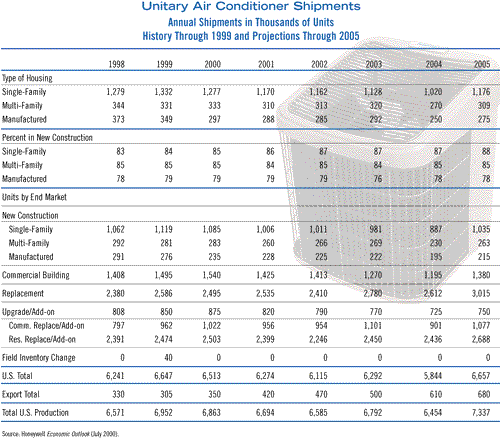After another record-breaking pace in the first quarter of 2000, shipments slowed a bit in the spring. June, however, was a new all-time record month and the pace to date is 10% ahead of last year.
Even if there is some slippage in the second half, this year could set yet another record.
Cooling degree data for 99 indicate that last summer was about 2% warmer than normal across the country. But it was 25% warmer in the Northeast, where air conditioning saturation is the lowest. The increased a/c installations in the region boosted the percentage of occupied units from 20% up to 24%.
This year, the Southwestern states had a significantly warmer-than-normal spring, and a heat wave gripped the Southwest again in the summer
Can We Sustain It
Although unitary shipments through June are well ahead of last year’s record level as noted above, the Honeywell report states that “It will be difficult for the industry to keep up with its 1999 pace in the last half, as slower housing markets and higher financing costs trim opportunities. A 6 to 7 percent decline in unitary volume over the third and fourth quarter will prevent the industry from realizing a significant increase in shipments this year.”However, the forecast concedes that the strength of the replacement market could still allow one more record year, despite any slowing in the economy.
With this in mind (see accompanying table, page 32), expect shipments to be close to 99 levels this year and decrease 4% in 2001 as new construction subsides. Replacements will likely remain strong through next year, then ease a bit. Total shipments are expected to average approximately 6.3 million units from 2002 to 2005, “declining by 10 percent… in the event of a recession,” the outlook states.
New installations grew almost 5% in 99 to a record of almost 3.2 million units. The Commerce Department estimates that 84% of new single-family homes last year had central air, which has been steadily increasing since 91 and is expected to continue to increase.
“The expansion of the housing stock in the South and Southwest (where air conditioning is installed in 99 percent of new homes completed) over the next five years will keep air conditioning’s presence in new construction on a growth path,” the report continues. By 2005, an estimated 88% of new single-family homes will have central air.

Calling for Replacements
Replacements are driving the industry while construction oppor-tunities decrease.The volume of replacements is expected to increase 4% in 2000, following jumps of 20% in 98 and 7% in 99.
However, the outlook predicts that replacements will ease to below-trend levels as a result of the three consecutive years of accelerated activity.
Replacements of commercial equipment are expected to decrease after matching the 99 peak this year.
Over the next five years, customers concerned with improved energy efficiency, indoor air quality issues, and refrigerant planning will spur steady replacement of unitary equipment in the residential and commercial markets, keeping shipments at historically high levels. Replacements will be 56% of production by 2005, up from 51% in 99.
Publication date: 08/21/2000


Report Abusive Comment